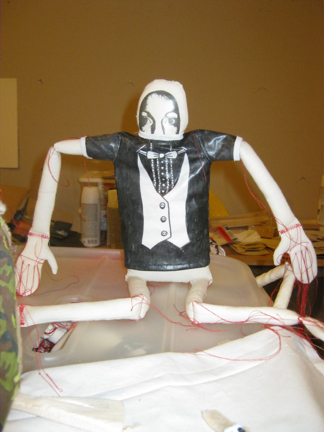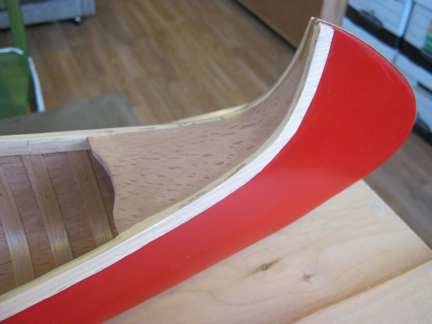The Making Of…Chestnut Complex, Part 2
While I waited for the paint to dry on the canoes, I began work on the figures. Running with the idea of extirpation and extinction I began to research New Brunswick species that fell under either of these two categories.
I chose to create a woodland cariboo, a great auk, and a grey wolf as passengers in the large canoe. The smaller canoe – the second test, which I ended up completing – would be towed behind (I settled on this unusually long and skinny composition as it would fit perfectly on the half-wall at the entrance of the gallery). Inside the small canoe would be three small brown bats as passengers, a species in crisis (and not just in New Brunswick) that has been featured in recent news.
The woodland cariboo figure harks back to a character in my Survival Game Series, a hunter in meticulously hand-painted camouflage dressed as a cariboo. I was particularly pleased with how the headpiece came together, looking a bit like medieval armour.
The great auk wears a tuxedo t-shirt and baseball cap. From pattern, to tests, to final piece, the cap was a full day’s work.
The t-shirt was made by hand drawing the design with India ink onto iron-on transfer sheets, which were then transferred to lightweight white jersey knit and sewn using my custom t-shirt pattern. When I was dressing the figure, I liked the pulling-over-the-head-posture so much that I decided I would use it in the final piece.
I visualized the grey wolf as a businessman in a shoebox wolf mask. Finding the right grey fabric meant buying several half metres of lightweight Italian wool suiting (and all those different shades of grey have me thinking of another piece involving several grey suits!). The dress shirt in progress:
The suit in progress:
The shoebox I made to make the mask out of:
Figuring out placement in a second large canoe made with shiplap plank construction (I decided I didn’t want shiplap, so it was left unfinished).
In five days time the paint on the canoes had dried (big relief!) and I could add gunwales, decks, and clear coat the interior wood surfaces.
They turned out better than I could ever have imagined. So happy. 🙂
As passengers in the small, 24” long canoe, the brown bats needed to be reduced in size to 10” standing height, approximately half of my standard figure scale. Turning the hands after sewing them at this scale is almost impossible without destroying them in the process. Out of the first 12 hands only six were usable.
Two of the bats are dormant, signified by their posture and lack of eye-holes in their masks. The third, infected with White Nose Syndrome, has been woken.
(Note: I had already mailed the finished canoes to the gallery at this point so the canoe I’m using for determining figure placement is the very first, poorly scaled, plaster covered test).
Sadly I have no documentation of the finished piece to share with you at this point. I wanted to give the canoes plenty of time to travel to the gallery but needed to keep the figures with me so I could complete them.
The work is now on its long journey home, with professional documentation planned for early January. I promise to let you know when the newly documented work has been added to the online gallery. 🙂
While I was making the small bats I really felt that I needed to explore these creatures in a much larger volume…read more about it in tomorrow’s post!












